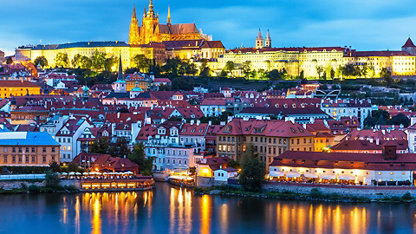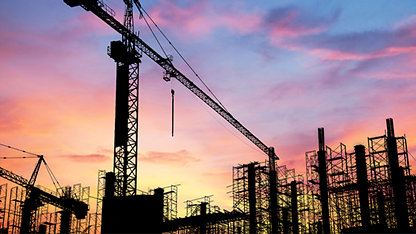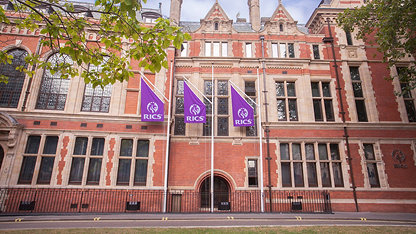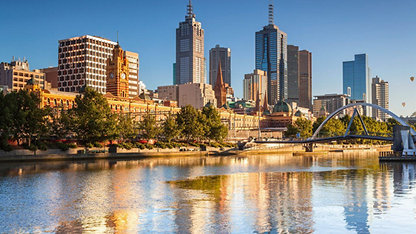In a world rapidly shifting towards urbanization, with an estimated 68% of the global population projected to live in cities by 20501, the question arises: can we restore nature's touch within our concrete jungles? The call for a sustainable future resonates louder than ever, and one visionary concept gaining momentum is the integration of nature-based solutions into our built environment. The UK Green Building Council has called for all new buildings and infrastructure to include nature-based solutions by 2030. Could green walls be part of that vision?
Origins of living walls
The concept of green walls, also known as vertical gardens, dates back to ancient civilisations. One of the earliest known examples traced back to the hanging gardens of Babylon. This garden, built in the 6th century, featured terraced gardens with plants and trees growing on the walls on the terraces.
In more recent years, a French botanist, Patrick Blanc became interested in using living plants to create vertical gardens as a way to beautify urban environments and improve air quality. Six years later in 1986, Blanc installed his first vertical garden on the exterior of a building in Paris. This design consisted of a series of metal frames attached to the building's facade, with pockets of soil and plants inserted into the felt material. Blanc's innovative approach to vertical gardening quickly gained popularity, and his designs have since been installed on buildings and public spaces around the world.2
In the 1990s, the concept of living walls continued to develop with an increased use of different types of materials and technologies. This period was responsible for the growth of modular panels, LED lighting and automated irrigation systems. The modular panels made the walls easier to install and maintain whereas the LED lighting and irrigation systems enabled vertical gardens to be located indoors as well as outdoors.
Today, vertical gardens- also known as ‘living’ or ‘green’ walls, are a popular new feature for buildings and projects but what actually are green walls?
What are green walls?
A green wall is a vertical structure intentionally covered with vegetation, which can be installed both indoors and outdoors. They are also known as ‘living walls’ ‘bio-walls’ or ‘vertical gardens. Green walls can be constructed using various techniques, though in general they are constructed in a very similar manner to that of normal walls. These types of walls produce numerous benefits including improved air quality and, thermal insulation, and aesthetic appeal. Green walls are growing in presence, especially within urban areas with rising temperatures. Singapore has proven to be a key player of this growth as approximately 49% of buildings have been greened!
In the UK there is a growing presence of green walls around tourist hotspots such as shopping centres. In 2018, a double-sided living wall was installed outside the Westfield Shopping Centre, Shepherd’s Bush. This location is Europe’s largest retail destination with 477 shops and 31.2 million annual visits. The wall was designed and installed by Pritchard&Pritchard, and it consists of 35,000 plants as well as irrigation, feeding and drainage systems3.
Another example is the green wall located at the Caixa Forum Museum in Madrid. This features a vertical garden designed by Patrick Blanc using his Le Mur Végétal system. The living wall, located in the heart of Madrid's cultural district, consists of over 15,000 plantings on a hydroponic structure. The wall was designed to withstand Madrid's hot summers and cold winters. It is estimated to weigh 30 kilograms per square meter and includes plants of various species adapted to the region. The irrigation and fertilization system are monitored and automated, with a recovery system in place to minimise water loss. The living wall adds a vibrant and environmentally beneficial element to the museum's surroundings.
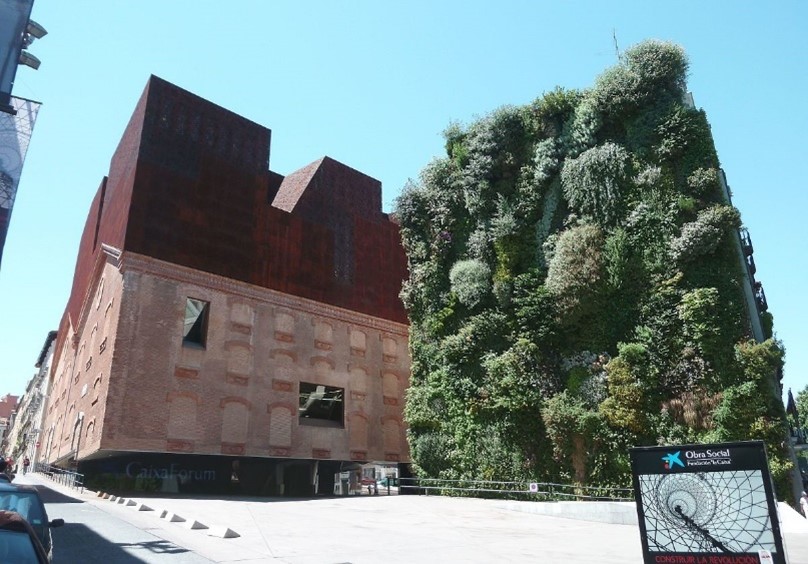
There are several types of green walls but the most common are:
Modular Panel Systems have plants pre-grown into the panels and can be used in a wide range of climates including both indoors and outdoors. They are typically constructed using modular panels that are pre-grown off-site and then installed on a supporting structure, such as a wall or frame. These panels consist of a metal or plastic frame which contains a growing medium, which is another term for word for a substrate such as soil. In addition to that, a network of irrigation pipes and drainage channels are added in order to keep the plants healthy. The panels are then covered with vegetation.
Felt System: This is another type of modular system that uses a sheet of felt as a growing medium. The felt tends to me made from recycled materials and the pockets are designed to hold the plants and soil. The felt is then attached to a frame or backing board which is then mounted onto the wall. The plants are inserted into the pockets and the roots grow through the felt in order to reach the soil. The benefit of this system is that it is easy to install, however the system requires frequent watering and additional irrigation systems to keep the felt moist to encourage growth of the plants.
Trellis System: This is also known as a wire or cable system as it is a type of green wall which uses a trellis or wire mesh to support climbing plants. This system is attached to a wall and the plants are trained to climb up the trellis using twine, clips or other methods of support. This method is useful as it allows for a variety of plant species, and it can be easily customed to the consumers’ requirements. It also requires less maintenance than a felt system as the plants can absorb moisture from the surrounding air and therefore does not require frequent watering. Plants within trellis systems may require frequent pruning to maintain the desired shape and size.
What’s the process of creating a green wall?
Generally, the steps to creating a green wall include choosing a location, selecting the plants, preparing the support structure, and installing the plants and maintenance.
1. Selecting a location: green walls have many proven benefits outdoors though most notably they can reduce noise levels, reduce temperatures, and improve air quality which makes green walls a suitable option for urban environments with poor air quality. Green walls can also be located indoors within a variety of different settings, such as offices or shopping centres. Research suggests that nature creates a calming atmosphere, therefore this can increase productivity and reduce stress levels in both working and leisure environments.
2. Selecting the plants: The type of vegetation used within green walls is dependent on many factors such as climate, location, light and maintenance requirements however common examples include:
- Ferns - with the ability grow in low-light conditions, ferns are a great option location with reduced sunlight or northwards facing walls.
- Succulents - due to being drought-tolerant, succulents are a suitable for arid climates.
- Grasses - grass is a widely used option as it can be easily maintained, sourced and it can add texture to the wall.
- Mosses - moss can grow in shade, therefore it is suitable to be used on the lower levels of large buildings. Moss also requires little maintenance in-comparison to other types of vegetation.
- Herbs - herbs tend to be used to provide natural fragrance to an area.
- Flowers - due to the added colours, flowers tend to be added to many green walls to not only add visual interest but to help attract pollinators.
3. Preparing the support structure: The support structure needs to be prepared, whether is a modular panel, felt or trellis system.
4. Installing the plants: The plants are installed onto the support structure by using a range of methods depending on the type of green wall, this could involve adding soil and using pockets, clips to place and hold the plants in place.
5. Maintaining the green wall: Regular maintenance is required to keep the green wall healthy. This process can include, watering, pruning, fertilising, and monitoring the plants for disease.
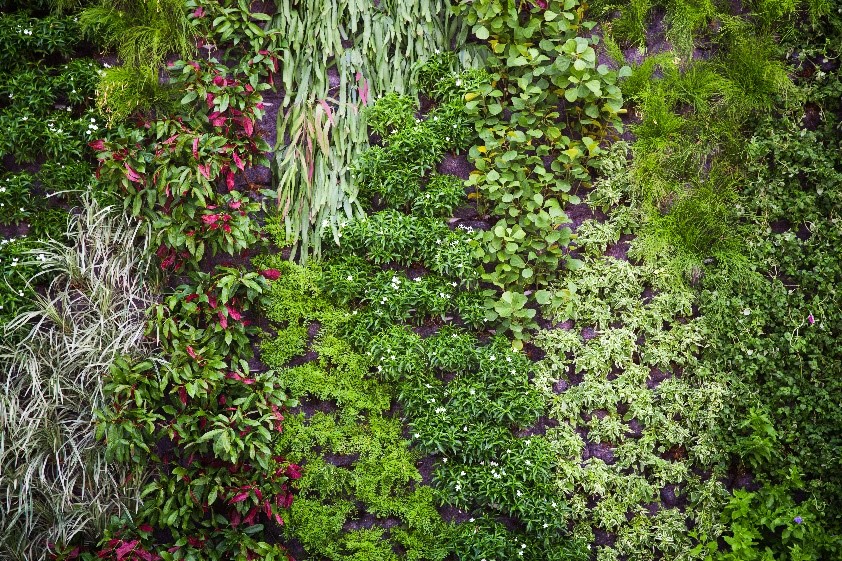
What are the costs?
The cost of a green wall can vary widely depending on factors such as the size, design complexity, plant selection, maintenance requirements and installation method. Generally, the cost of a green wall can be broken down into two main categories: initial instillation and ongoing maintenance.
The initial costs can range from several hundred pounds for small-scale projects to tens of thousands of pounds for large-scale projects. The larger the project, the increased need for more complex irrigation systems. In addition to that the type of wall also has a reflection on the initial costs.
The ongoing maintenance of a green wall can also vary depending on the type of plants used, the level of maintenance required and the size of the installation. Maintenance typically varies from a few hundred to a few thousand pounds per year. This cost includes regular watering, fertilising, pruning, and cleaning of the wall to keep the plants healthy and aesthetically appealing. Depending on the type of green wall, specifically if it reflects a biome- a distinct ecological community characterised by its unique climate, flora, and fauna- which has different climate requirements than that found locally, maintenance costs could be increased.
Overall, the costs of a green wall may seem significant. However, there are many benefits, which are listed below, that have proven to decrease costs in specific areas.
Why green walls?
Removal of air pollutants
The addition of green walls to an urban area can remove air pollutants through process called phytoremediation. This process is split down into four main areas:
- Plant Uptake: Plants absorb pollutants through their leaves, stems, and roots, and convert them into harmless substances. Green walls are designed with plants that have a high surface area, allowing them to absorb a larger volume of pollutants.
- Microbial Degradation: Microorganisms in the soil can also break down pollutants into less harmful substances. The plants in green walls provide a favourable environment for these microorganisms to thrive, helping to break down pollutants in the soil.
- Physical Adsorption: The roots and leaves of plants can act as filters, trapping pollutants in the soil and air. This can help reduce the levels of pollutants in the environment.
- Evapotranspiration: Plants release water vapor through a process called evapotranspiration. This can help humidify and cool the air and can also help remove pollutants that are soluble in water, such as volatile organic compounds.
In addition, green walls can be specifically designed to help best improve the air quality in specific regions. This is because each species of plants has the capacities for remediating different types of contaminants. Let’s use Shanghai as an example. This city is exposed to the highest amounts of nitrogen dioxides (NOx) in the world. Grasses, shrubs, ivy and sunflowers can absorb nitrogen oxides through the process of phytoremediation. Therefore, a green wall could be specifically designed using the following species switchgrass, juniper, yew, ivy, and sunflowers to absorb the most NOx as efficiently as possible which not only impacts the environment, but the area that we breathe in.
Reduced urban temperatures
Evapotranspiration, previously mentioned as a method of removing air pollutants, also helps reduce temperatures. This is mainly due to three factors, the cooling affect, insulation, and shading.
- The cooling affect is a process in which the air is cooled by the released vapor that is released from the plants during evapotranspiration.
- As green walls act as insulation, they help reduce the heat transfer from the sun to the buildings. This helps keep buildings cooler in the summer which reduces the demand for air conditioning. The natural insulation also helps reduce heat loss in the winter which similarly reduces the demand for indoor heating methods. Due to this, the insulation provided by green walks can reduce energy costs by as much as 20%
- Green walls provide an element of shading which helps reduce the amount of direct sunlight which reaches buildings and other surfaces which helps to reduce heat absorption.
Improved biodiversity
Green walls provide a habitat for plants to thrive in. These plants can then provide suitable living environments for insects, birds and other animals. Similarly, green walls can create microclimates which are small areas with unique climates. Microclimates are able to support alternative plant species that may not be able to grow in other areas which then attracts a different variety of insects and animals. Flowers are commonly used within green walls, their presence is important as they attract pollinators such as bees, butterflies, and hummingbirds. These pollinators play a vital role in encouraging the growth of the plants which helps maintain heathy ecosystems.
Reduced flood risk
Plants within walls can be used to attenuate rainwater runoff- this means slowing down the flow of rainwater allowing it to soak onto the ground more effectively. This process can help to reduce the risk of flooding and erosion. As green walls consist of a large number of plants, during rainfall a significant amount of water is absorbed through their leaves and roots. This helps reduce the volume of water which runs off the surface of the wall. In addition to that, some walls are actually designed to store rainwater in a reservoir. This water is then reused for irrigation and other purpose which not only decreases ongoing maintenance costs but reduces the volume of wastewater.
Improved health
Green walls can provide a range health benefits, both physical and mentally. Arguably, the most important health benefits are due to the improved air quality. As the plants absorb harmful pollutants and release oxygen, a healthier breathing environment is created. This can lead to health benefits, such as reduced rates of respiratory illness, which can help to reduce healthcare costs. Research has proven that the presence and connection with nature reduces stress levels and improve mood. In addition to that, research suggests that exposure to greenery can improve cognitive function which can lead to increased productivity within working environment.4
In conclusion, green walls offer a promising solution for restoring greenery and enhancing sustainability in our concrete jungles. With the increasing urbanisation and population growth, incorporating nature-based solutions like green walls has become essential for creating healthier and more liveable cities.
Aaliyah Pollock
Data and Tech Analyst
2https://floraurbanica.com/en/history-of-green-walls/
3 https://green-roofs.co.uk/case/1400m2-living-wall-westfield-west-london/
4http://www.greenovergrey.com/green-wall-benefits/health-wellness.php







